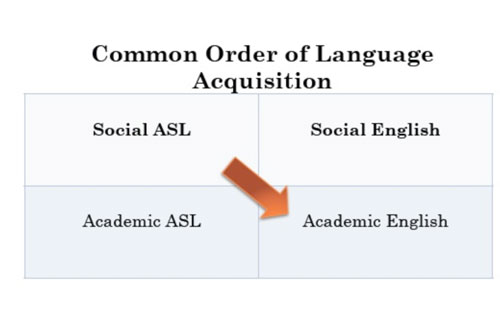 Literature is the foundation of much of our educational experience. For mainstreamed students and their interpreters, the challenge of representing both the form and meaning in literature is stimulating and overwhelming. This mini-workshop is designed to an approach to interpreting literature based on Schleper’s 15 Principles for Reading to Deaf Children (Gallaudet University, Clerc Center)
Literature is the foundation of much of our educational experience. For mainstreamed students and their interpreters, the challenge of representing both the form and meaning in literature is stimulating and overwhelming. This mini-workshop is designed to an approach to interpreting literature based on Schleper’s 15 Principles for Reading to Deaf Children (Gallaudet University, Clerc Center)
The presentation will include presentation of theory and small group discussions focused on the following questions:
- “How can we introduce literature to the youngest students? What is the focus of our interpretations?
- “How do interpreting strategies change as the student progresses through the grades?”
- “What are the limits to the interpretability of English literature in the classroom?”
- “What is the role of fingerspelling in bridging a visual representation of literature to the written/auditory form?”
PDF of Presentation for Interpreting English Literature
"Interpreting Literature" Resources
Narrative Resources
Here are resources related to Narrative Skills – as some towards understanding other discourse genres as well.
The clip of the Coyote
Debbie’s Rendition of the Coyote Clip
A Clip of Quidditch
Debbie’s Rendition
Other Video Resources
Social Literacy
Social Literacy
Resources from the field of Speech and Language Pathology can be extremely useful in developing these social literacy skills. You may nave a Speech/Language clinician who is a part of the team who you can work with and get other ideas for how to support this work. (In the same way that you might tutor a student with the support of a teacher, you may work on social interaction with the support of the a speech/language clinician.)
Another suggestion for developing social literacy is including the student as an assistant teacher in ASL instruction for their peers. For some students who are hard of hearing or use a cochlear implant, it may develop a higher regard for the use of sign language and provide a greater benefit for having an interpreter as part of the educational team. Additionally, it can help provide a role for the student that needs to focus on taking turns within the activities and clue students in to the ways that people need to wait for their turn.
BICS & CALP/Academic ASL
Why Academic ASL Matters to Sign Language Interpreters
This is a presentation by Dr. Ben Bahan at StreetLeverage in Fremont, California in 2016. The video of the presentation is presented as well as an English translation. Though it takes more time to watch the ASL, I would recommend it is worth it to see such an excellent example of Academic ASL.
Dr. Bahan refers to the work of James Gee who is a social linguist and literary theorist who focuses on “Discourse” – differentiating between the primary Discourse a person learns in their family of origin and the “secondary Discourse” they learn in other settings. (Which connects to the idea of BICS/CALP described below. Read more about Gee’s work in his article “What is Literacy?”
Importance of Early Exposure to ASL
Henner et. al. American Sign Language Syntax and Analogical Reasoning Skills Are Influenced by Early Acquisition and Age of Entry to Signing Schools for the Deaf. Front. Psychol., 26 December 2016 | https://doi.org/10.3389/fpsyg.2016.01982
This article shares research about the impact of the age of acquisition of ASL for students. Importantly, it points out that early exposure to ASL is a benefit for both signing skills, but also cognitive development – which supports the acqusition of speech skills as well.
BICS/CALP
More information about Basic Interpersonal Communication Skills & Cognitive Academic Language Proficiency
- An article on BICS/CALP from the field of teaching English as a second language
- Information from Wikipedia on Professor Jim Cummins & BICS/CALP
- An ASL presentation of Kindergarten Readiness for Deaf students on ASLized.org
Learning English as a Second Language

The bottom graphic demonstrates what is often attempted for Deaf and Hard of Hearing students – which in part explains such poor results.
Academic ASL
 A blog supporting using ASL to developing BICS & CALP
A blog supporting using ASL to developing BICS & CALP- Resources from Gallaudet on ASL Composition
- ASL in Academics Lecture Series at Gallaudet
- Deaf Studies Digital Journal at Gallaudet University (The first journal published in ASL.)
- ASLized.org: This is a site designed to the promotion of ASL and provides ASL texts in a variety of genres.
A Video presentation of Dr. Raychelle Harris on Academic Discourse in English and ASL (Provided in ASL with English captioning)
The kick off lecture for the ASL in Academics Lecture Series
Use of Academic ASL in a High School Math Class
See the Mirrored Math resource.
Answers to Math Questions from Veditz
Interpreting Literature
- Shared Reading Project, Gallaudet University
- Visual Language and Visual Learning (VL2) at Gallaudet’s Science of Learning Center
- Classroom interpreting web site (direct link to “Interpreting and children” page) – Boy’s Town
Hop on Pop: English version
Hop on Pop: ASL phonemes
The Story of Ferdinand: ASL sample (From ASL Inside)
To Kill a Mockingbird AudioBook sample
Fingerspelling Resources
- The Importance of Fingerspelling from VL2 at Gallaudet
- The Transition from Fingerspelling to English Print by Tamara S. Haptonstall-Nykaza and Brenda Schick
- Presenting Rare Words by Kevin Williams
On Fingerspelling Tests
Recognizing that the most dynamically equivalent way to represent spoken English in sign language is through rapid fingerspelling, Kevin Williams articulates why this approach is an effective option. That just as hearing students get phonemic clues that they need to put together to actually spell the word, deaf students can get phonemic clues from rapidly fingerspelled words but need to be able to translate those fingerpselled letters into a written word.

